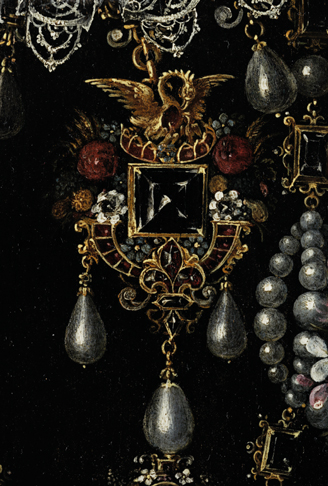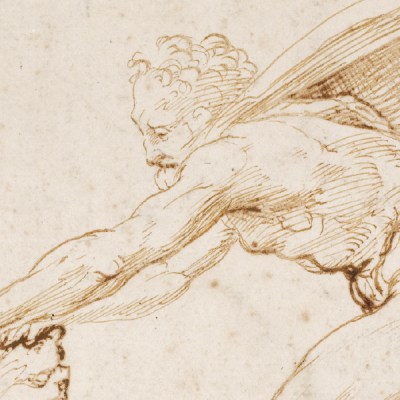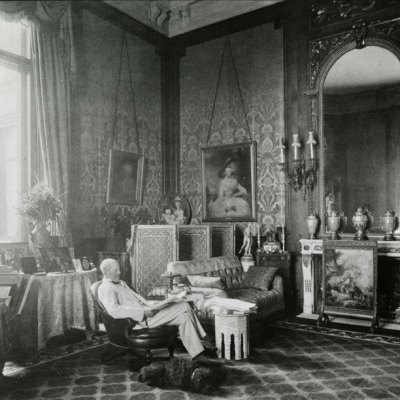Working at Waddesdon Manor brings many surprises. I should be used to the range and richness of Rothschild collections, but I never expected to encounter two masterpieces here that are almost certainly by the English artist Nicholas Hilliard (1547–1619). Even less, that these two paintings would turn out to transform our understanding of his work.
Queen Elizabeth I (1533–1603) (1576–78), attributed to Nicholas Hilliard. Rothschild Family/Photo: © Hamilton Kerr Institute

Queen Elizabeth I and Sir Amias Paulet are on loan to Waddesdon from a Rothschild family collection and will be the focus of a special display from 7 June. It was while they were undergoing conservation at the Hamilton Kerr Institute, Cambridge, that findings made by Rupert Featherstone and his team suggested they might be by Hilliard. The artist is famous for his miniatures, painted in watercolour on vellum, but there is archival evidence that he also painted some large-scale paintings. Scholars have suggested various oil paintings might be by, or produced under the direction of Hilliard (including the Rothschild Elizabeth, attributed to Hilliard by Roy Strong in 1983, and the ‘Phoenix’ and ‘Pelican’ portraits of Elizabeth I at the National Portrait Gallery, London, and Walker Art Gallery, Liverpool, respectively), but these attributions have relied entirely on stylistic affinities with the artist’s miniatures, and it is difficult to compare works of such different scales, types, and materials conclusively.
The Rothschild portraits display many similarities with Hilliard’s miniatures, particularly in the treatment of the eyes, hair, and lace. The portrait of Elizabeth conforms to the face pattern used in the ‘Phoenix’ and ‘Pelican’ portraits, both derived from Hilliard’s 1572 miniature portrait of the queen (National Portrait Gallery). What allows us to link the Rothschild portraits to Hilliard with unprecedented confidence is a new discovery about the wood on which they are painted. The panels are formed from boards of oak of French origin. It is extremely unlikely that an English artist would have chosen French oak over the wider, straighter-grained Baltic oak, from which English panels were usually constructed, unless there were some exceptional circumstance.
Sir Amias Paulet (c. 1533–1588) (1576–78), attributed to Nicholas Hilliard. Rothschild Family/Photo: © Hamilton Kerr Institute

The sitter in the male portrait, Sir Amias Paulet (c. 1533–88), gives us the reason and further tightens the link between the portraits and Hilliard. Paulet was Elizabeth I’s resident ambassador in France from 1576 until 1579. Hilliard was himself in France from 1576 until 1578 and part of Paulet’s retinue for some of this time. Elements in the portraits highlight their French context, including the fleur-de-lys on Elizabeth’s pelican jewel, which is part flattery, part swagger. At the time, the queen was considering marriage to the duc d’Anjou, the French king’s brother, and had also revived the English claim to the French throne.
I loved seeing the paintings on easels at the Hamilton Kerr, at different stages of conservation and in different lights, with scholars with deep expertise in Elizabethan portraiture. On each visit, Sarah Bayliss, who carried out their conservation, had more to reveal. Discussion ranged from the protocols of hat wearing at court to the technologies of diamond cutting and the Frenchness (or not) of Elizabeth’s sleeves. A visit by curators from the National Portrait Gallery led to a generous loan of the ‘Phoenix’ portrait to Waddesdon – the first opportunity to study the paintings side by side.
Detail of Queen Elizabeth I, showing the queen’s pelican jewel Rothschild Family/Photo: © Hamilton Kerr Institute

I have been lucky to get to know the paintings slowly and in great detail; and I hope that visitors to Waddesdon will be able to pause and look closely. If they do, they will see the veil that wrinkles around the queen’s shoulders; the posy of natural flowers on her bodice, and the enamel wheat and roses on her pendant; the precise delineation of Paulet’s greying hair and the stubble on his cheek. You think the blacks are flat black, until you see the patterns in the textiles – black on black. You think the ruffs are flat too, until you see them in raking light. Hilliard thickened the white paint so that the lace sits slightly proud of the surface, giving it a vivid materiality. The eye is repeatedly drawn back to the jewels, although it is hardly surprising that Hilliard – a trained goldsmith – makes such virtuosic show of them. I particularly like the great pyramidal diamond at the top of Elizabeth’s diadem, which looks like an architectural structure, and the strange ornaments on the queen’s shoulders – hard pearls encircled with something that I imagined to be swan’s down, but which is probably silk.
I berate myself for paying more attention to the portrait of the queen than to that of her ambassador. But of course this is exactly what we are supposed to do. The pairing of portraits of a monarch and an ambassador is almost unheard of, and in some ways they must remain separate. Although the two sitters share the red velvet curtain as a background, only Paulet looks directly at us, inhabiting our space.
‘Power & Portraiture: Painting at the Court of Elizabeth I’ is at Waddesdon Manor, Buckinghamshire, from 7 June–29 October.
From the June issue of Apollo. Preview and subscribe here.


